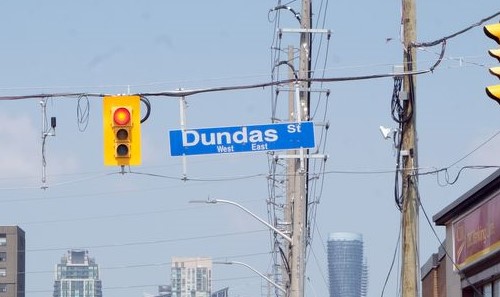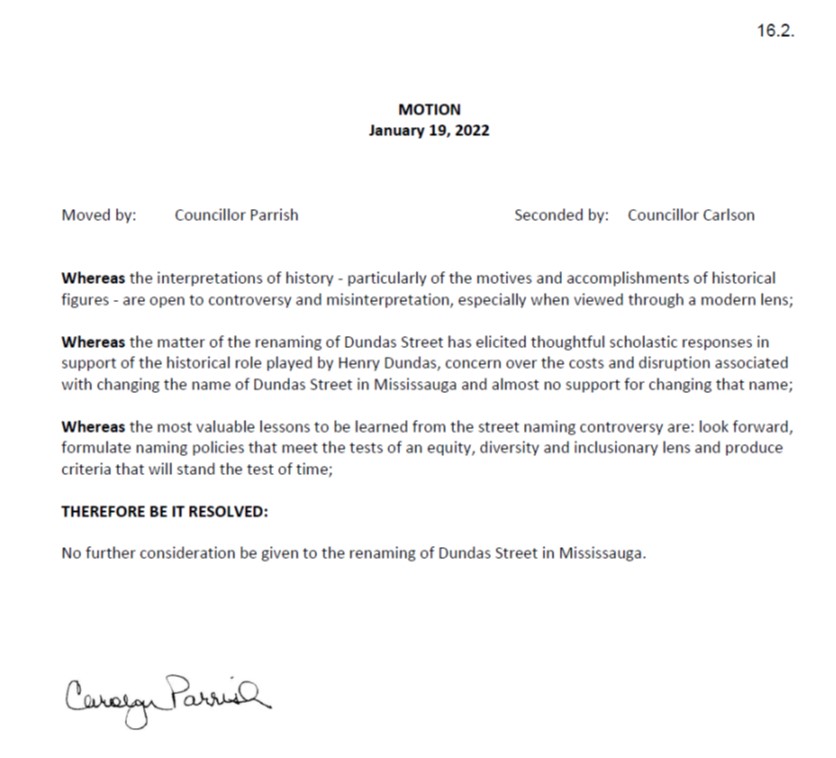Dundas stays.
The name of the road has been etched on our landscape for over 200 years, and countless citizens over innumerable generations have interacted and connected with the road, and as a by-product, the name.

We also know over the recent past the wider societal discussions over colonial place names, and the modern revaluation and reinterpretation of names, people and events from our past. In many cases, these conversations and considerations are long overdue.
The name of Dundas on our landscape also fell under scrutiny, and it has been an interesting exploration into what names mean, why they were applied, who applied them, and what is our modern take on historical references. The name of Dundas has been scrutinized for its association with the slave trade and the abolition of slavery in the British Empire. We will get back to this.
In the wake of Toronto announcing their plan to rename Dundas Street, other municipalities also began to look at “their” references to Dundas. That process has not been taken lightly. If you did not catch it, last week the City of Mississauga Council passed a motion to no longer consider the renaming of Dundas Street. Dundas stays, warts and all.
https://pub-mississauga.escribemeetings.com/filestream.ashx?DocumentId=19116
I could spend a great deal of time rehashing what many have already eloquently explored. The skinny is that Dundas Street was named by Lt-Governor John Graves Simcoe after Henry Dundas, Secretary of State for the British Home Department and a leading politician. The name idea for this road was recorded by Elizabeth Simcoe, John Graves Simcoe’s wife, on Tuesday, September 23, 1793:
“Mr. Smith has gone to open a road, to be called Dundas Street, from the Head of the Lake to the River La Tranche (the Thames).”
This reference establishes the plan of using “Dundas” as the name for the road in 1793, which perhaps allows us a glimpse into the thought process behind the naming. Simcoe arrived in Canada in November of 1791, and as such his formative interactions with Henry Dundas that would influence his choice of naming likely took place prior to Simcoe’s arrival in Canada. We know, in both documentary evidence and historical narrative, that Simcoe was a fervent abolitionist.

In 1791 Simcoe wrote: “The principles of the British Constitution do not admit of that slavery which Christianity condemns … The moment I assume the Government of Upper Canada, under no modification will I assent to a law that discriminates by dishonest policy between natives of Africa, America or Europe.”
In short, Simcoe wished to abolish slavery, and had often spoken out against slavery. However, in Upper Canada, a significant number of members of the Legislative Committee were themselves slave owners, and as such the best Simcoe could initially achieve was a compromise that saw the gradual abolition of slavery in Upper Canada:
&
But back to Simcoe’s inspiration for naming Dundas. Simcoe’s most direct interactions with Dundas took place prior to 1791, as there would have been limited communication between the two given after Simcoe’s appointment to North America. As such, Simcoe and Dundas were more closely involved with each other in pushing for the abolition of slavery before the discussions entered the fervent political realm on both sides of the ocean.
Prior to 1791, most view Dundas as a committed abolitionist, and he initially supported the 1792 motion by abolitionist William Wilberforce to abolish the slave trade. Dundas is quoted as saying: “My opinion has been always against the Slave Trade.”
Dundas had introduced a similar motion in 1791 which had been defeated. Dundas introduced an amendment to Wilberforce’s motion inserting the word “gradual” – this being a compromise, very similar to what Simcoe faced in Upper Canada. It is generally understood that Dundas did believe that the slave trade itself could not be effectively eliminated without banning slavery itself. There are some excellent sources on the subject that are most worthy of exploration:
https://arnistonhouse.com/wp-content/uploads/HENRY-DUNDAS-AND-ABOLITION-Nov-10-2020.pdf
But, on the premise that Simcoe’s relationship with Dundas was formed prior to 1791 and his arrival in Canada, Simcoe was not present during the 1792 Wilberforce motion and Dundas compromise – although Simcoe ended up having to follow a similar course of action.
With this, both Simcoe and Dundas were at the mercy of the political system of their time and could not autocratically pass a law to ban slavery outright. If there is fault, we should examine the political systems, and not specific individuals.
Both Simcoe and Dundas were flawed, and they were both products of the British Empire with strong colonial beliefs, and they were both firmly entrenched in the narratives of colonization – and they were certainly not alone. But both Simcoe and Dundas were early supporters of the abolitionist movement, even if as politicians they had to reach compromises.
The City of Mississauga’s decision to no longer consider the renaming of Dundas Street in our city acknowledges that the motives and accomplishments of historical figures are often open to controversy and misinterpretation, especially when viewed through a modern lens: In our collective conversations around topics that have helped to shape our modern world, we often search for simple, clear historical narratives. The Good and The Bad.
As with most cases, upon further examination, Dundas and Simcoe and the questions of abolishing slavery offer a clouded narrative that should not be taken out of the context of their times. Our city’s decision to retain the name is also coupled with a promise to “formulate naming policies that meet the tests of an equity, diversity and inclusionary lens and produce criteria that will stand the test of time.”
Certainly, there are other names on our modern landscape that will come under needed scrutiny, and they should. These ongoing discussions offer opportunities for further engagement around the story of us and our own colonial narratives, the legacy of slavery, our treatment of First Nations peoples, and our complicated histories. As John Stewart so beautifully wrote, learning the truth about our past “seems a much more beneficial exercise than trying to exorcise our colonial ghosts by changing some street signs.”
We very much look forward to contributing to the much needed and growing conversations around confronting the “ghosts” of our colonial roots. Let’s keep the conversation going as we seek to heal from the wounds from our past even as we move forward.




Comments are closed.